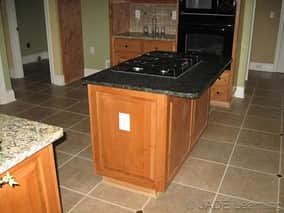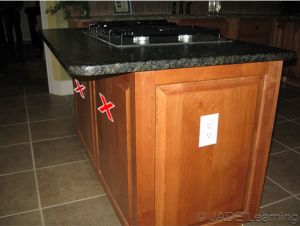Kitchen Island, Peninsular-Countertop, and Work Surface Receptacle Requirements
Published on December 2, 2020 by Jerry Durham
Understanding Section 210.52(C)(2) in the 2020 Code cycle
The 2020 National Electrical Code (NEC) has ushered in a brand-new method for determining the number of receptacle outlets required to serve island countertops; peninsular countertops; and work surfaces located in kitchens, pantries, breakfast rooms, dining rooms, and similar areas of a dwelling unit.
Comparing the 2017 and 2020 NEC Requirements
2017 NEC: Island, Peninsular, and Work Surface Receptacle Requirements

During the 2017 Code cycle, the electrician determined the number of receptacles required for both island and peninsular countertop surfaces and work surfaces by measuring the length and width of the countertop space according to NEC Sections 210.52(C)(2) and 210.52(C)(3). Both Sections agreed that only one receptacle would be required to serve these individual countertop spaces whenever the long dimension measured at least 24 inches and the short dimension no less 12 inches.
Simply put, an island or peninsular measuring 24 x 12 inches required one receptacle; it made no difference how much bigger the countertop space was beyond those initial measurements - only one receptacle outlet was required. The electrician was, of course, allowed to install as many additional outlets as the homeowner requested.
This long-standing requirement was easy to remember, worked seemingly well, and carried only minimal baggage, such as remembering that a peninsular countertop in the 2017 Code cycle began at the connected perpendicular wall and NOT where the peninsular countertop abutted the perpendicular countertop, as it was in the 2014 Code cycle.

But what the original Code could not do was guarantee a receptacle within reach of the countertop surface whenever the island, peninsular, or work surface was especially large. While it is reasonable to expect builders to provide additional receptacles for especially large islands and peninsular countertops in custom-built homes, it was not guaranteed by the 2017 National Electrical Code. And we must remember, the sole purpose of receptacle outlet spacing requirements in the NEC is not convenience, but safety. By increasing the number of receptacles along any wall space, the Code ensures a decrease in the use of extension cords and other less desirable methods for making appliances reach. And that is the objective with the new calculation requirements for determining the minimum number of receptacle outlets for island, peninsular, and work surfaces in the 2020 Code cycle.
2020 NEC: Island, Peninsular, and Work Surface Receptacle Requirements
Brand-new for the 2020 Code cycle, Section 210.52(C)(2) tells us that for island and peninsular countertops and work surfaces, receptacle outlets shall be installed in accordance with 210.52(C)(2)(a) and (C)(2)(b):
210.52(C)(2)(a) says at least one receptacle outlet shall be provided for the first 9 ft² (or fraction thereof) of the countertop or work surface. And then another receptacle outlet shall be provided for every additional 18 ft² (or fraction thereof) of countertop or work surface thereafter.
210.52(C)(2)(b) then tells us that at least one of those receptacle outlets shall be located within 2 ft of the outer end of the peninsular countertop or work surface. And that any additional required receptacle outlets can be located as determined by the installer, designer, or building owner. The location of all receptacle outlets shall be in accordance with 210.52(C)(3).

Example Countertop
An island countertop measuring 12 ft x 4 ft would require four receptacle outlets. Remember, up to 45 square feet of countertop requires three receptacle outlets, but a countertop area greater than 45 square feet up to 63 square feet requires a fourth receptacle outlet.
Summary of theNew Code Requirements in the 2020 NEC
In the 2020 Code cycle, when determining the minimum number of receptacle outlets required for an island or peninsular countertop or work surface, you must adhere to the following:
- One receptacle outlet is required for (up to) the first 9 square feet of countertop. This means from over zero to nine square feet of countertop you must provide one receptacle outlet.
- An additional receptacle outlet must be installed for each additional 18 square foot section (or fraction thereof) of countertop. This means from anything greater than 9 square feet up to 27 square feet of countertop, you must provide a second receptacle outlet. Beyond 27 square feet up to 45 square feet, you must provide a third receptacle outlet, and so on.
The NEC says that placement of the receptacle outlets is up to the installer, designer, or owner, as long as one of the outlets is installed within two feet of the outer end.
The new Code also indicates that the location of all receptacle outlets must comply with Section 210.52(C)(3), which tells us the outlets shall:
- Be no higher than 20 inches above the countertop surface.
- Be permitted to be installed within the surface of the countertop or work surface if the outlet is listed for such an installation.
- Be no lower than 12 inches below the surface of the countertop if the outlet is installed in the base cabinet.
- Not be installed in a base cabinet below the countertop or work surface where that surface extends more than 6 inches beyond its support base.

Learning the new rules for the 2020 Code cycle can be a daunting task. We hope we helped simplify the new receptacle outlet requirements for island and peninsular countertops and work surfaces in kitchens and similar areas.
